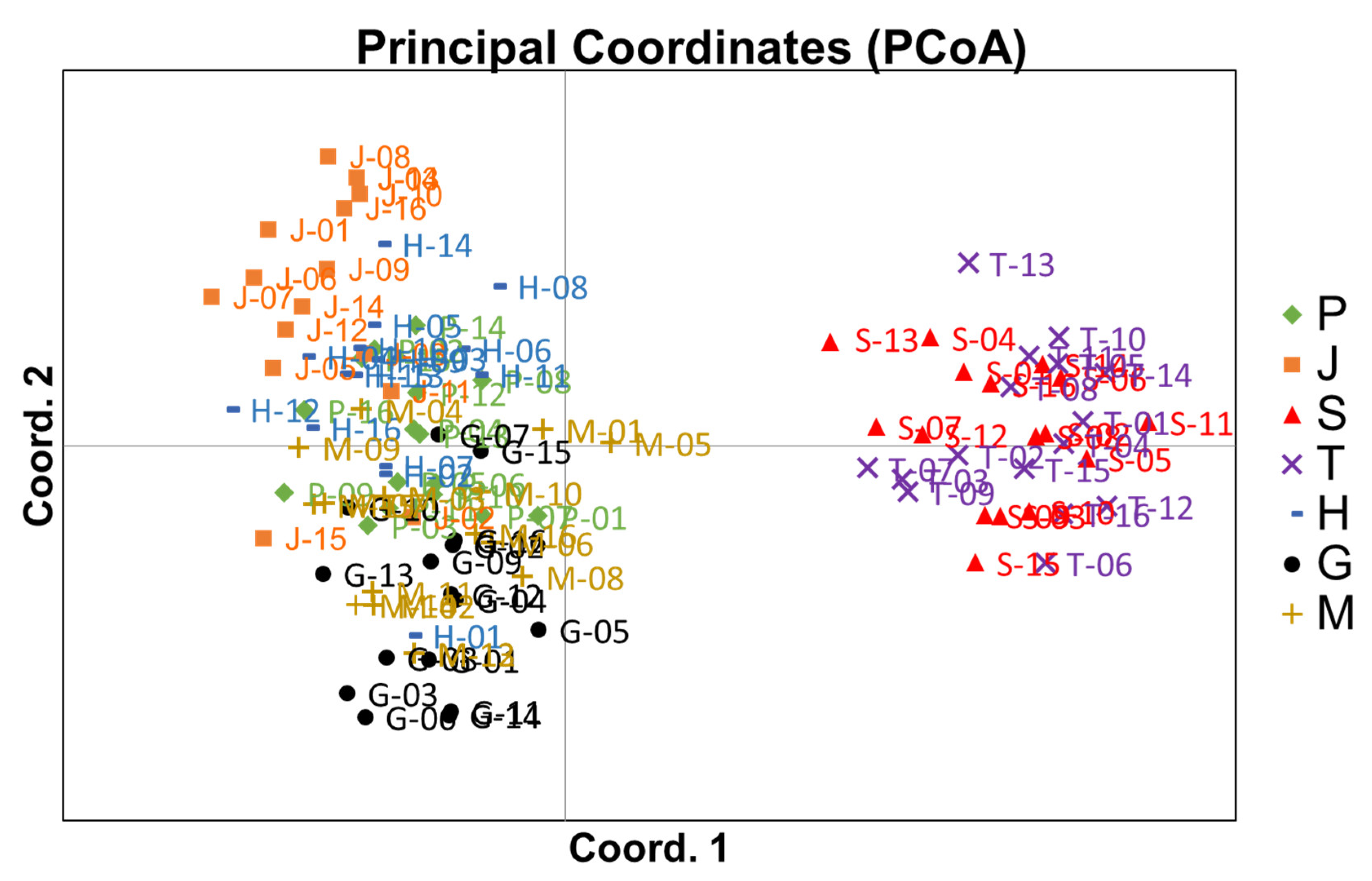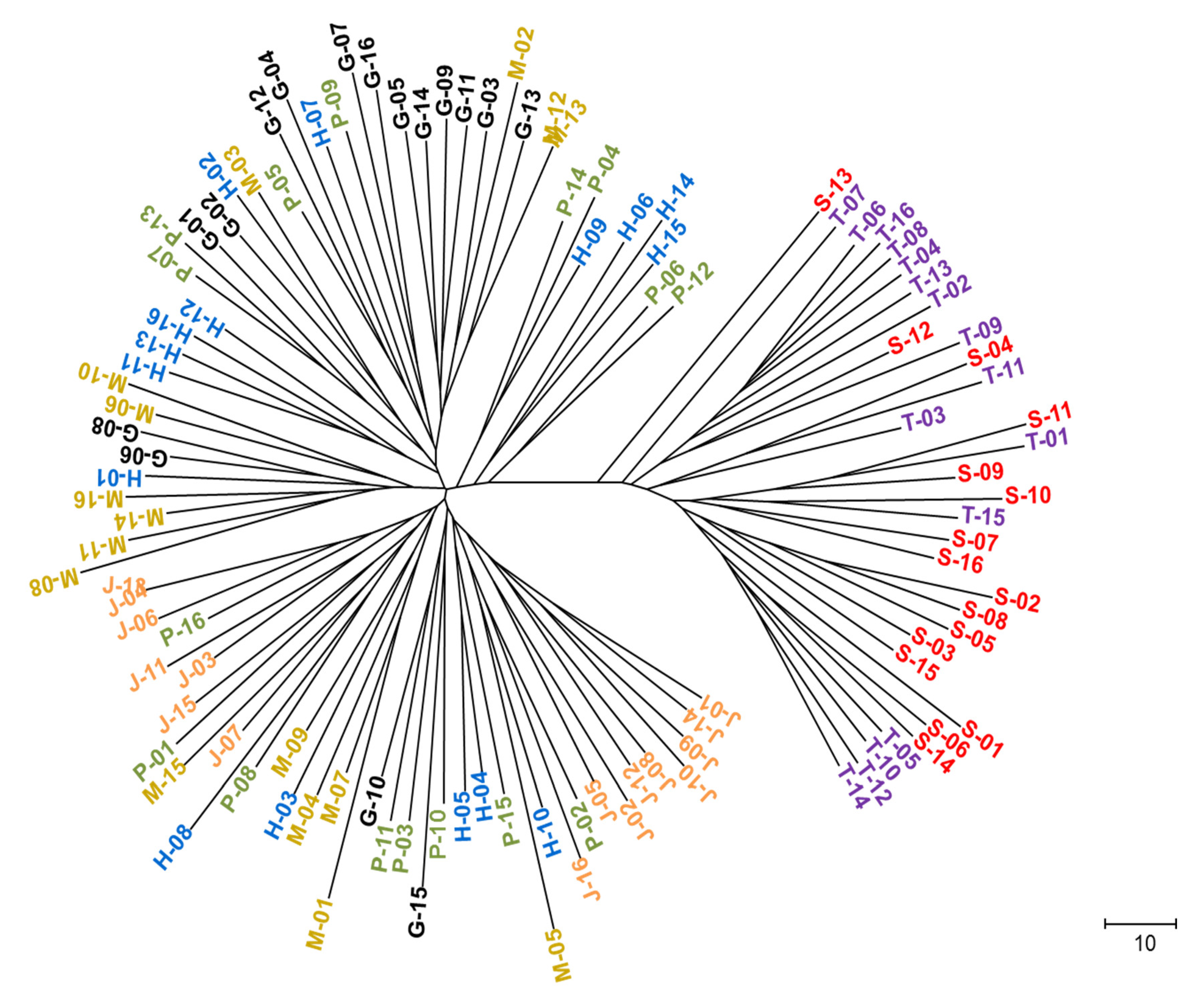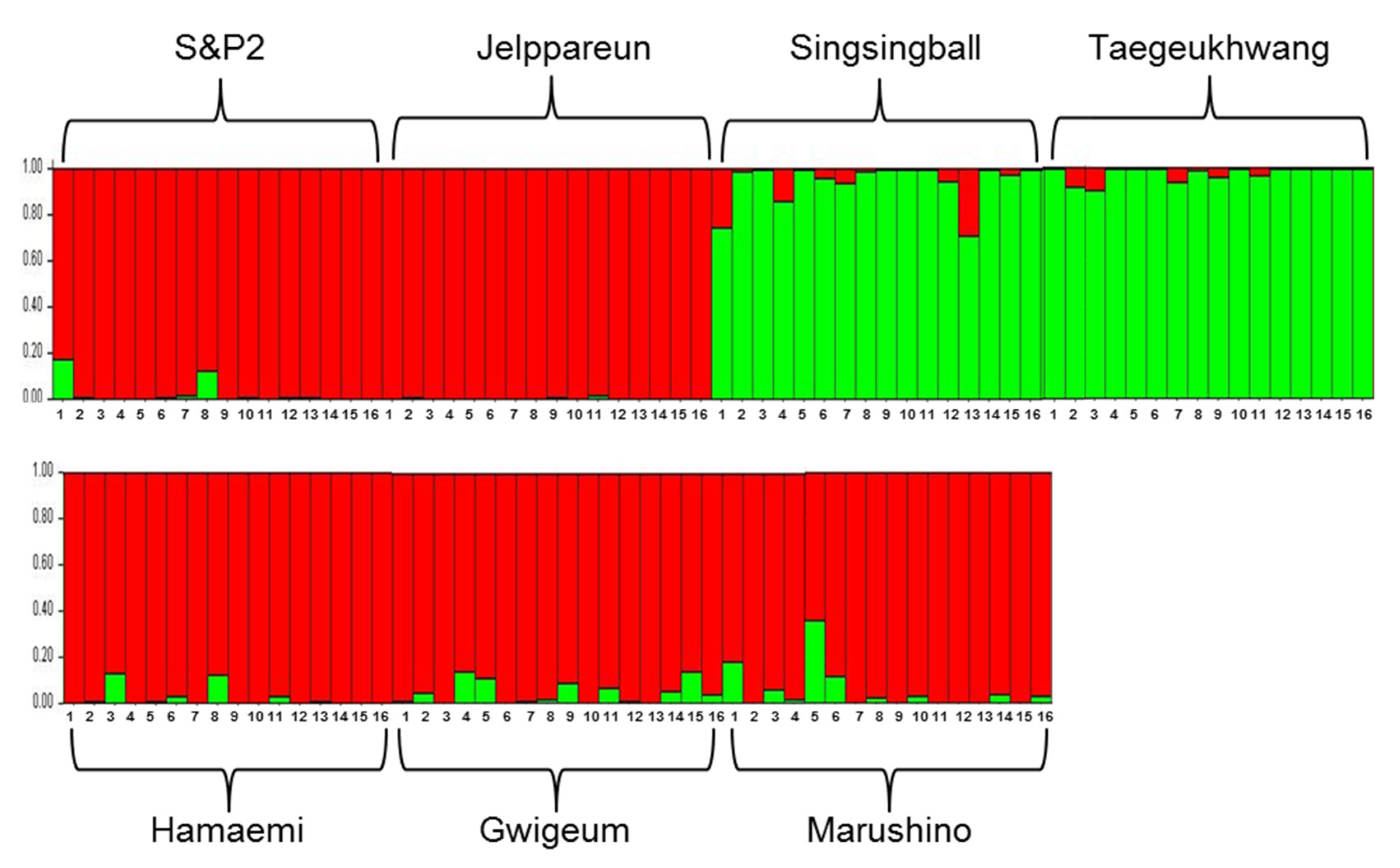Varietal Identification of Open-Pollinated Onion Cultivars Using a Nanofluidic Array of Single Nucleotide Polymorphism (SNP) Markers
Abstract
1. Introduction
2. Materials and Methods
2.1. Plant Material
2.2. Genomic DNA Extraction
2.3. Mining and Validation of Putative SNPs
2.4. Data Analysis
3. Results
3.1. SNP Discovery
3.2. Frequency of SNP Markers and Descriptive Statistics
3.3. Cultivar Authenticity
3.4. Genetic Relationship among Onion Varieties
4. Discussion
5. Conclusions
Supplementary Materials
Author Contributions
Funding
Conflicts of Interest
References
- Cope, R.B. Allium species poisoning in dogs and cats. Vet. Med. 2005, 100, 562–566. [Google Scholar]
- Fritsch, R.M.; Friesen, N.; Fritsch, R.M.; Friesen, N. Evolution, domestication and taxonomy. In Allium Crop Science: Recent Advances; CABI: New York, NY, USA, 2002; pp. 5–30. [Google Scholar]
- Grubben, G.J.H.; Denton, O.A. Plant Resources of Tropical Africa 2. Vegetables; PROTA Foundation: Wageningen, The Netherlands, 2004. [Google Scholar]
- Fritsch, R.M.; Matin, F.; Klaas, M. Allium vavilovii M. Popov et Vved. and a new Iranian species are the closest among the known relatives of the common onion A. cepa L. (Alliaceae). Genet. Resour. Crop Evol. 2001, 48, 401–408. [Google Scholar] [CrossRef]
- Silva, M.L.R.B.; Magalhães, A.G.; Mergulhão, A.C.E.S.; Candeia, J.A.; Silva, M.C.L.; Lyra, M.C.C.P. Phylogenetic relationships of onion (Allium cepa L.) cultivars by sequencing of the its region. J. Exp. Biol. 2013, 1, 6. [Google Scholar]
- Gurushidze, M.; Mashayekhi, S.; Blattner, F.R.; Friesen, N.; Fritsch, R.M. Phylogenetic relationships of wild and cultivated species of Allium section Cepa inferred by nuclear rDNA ITS sequence analysis. Plant Syst. Evol. 2007, 269, 259–269. [Google Scholar] [CrossRef]
- Rivera, A.; Mallor, C.; Garcés-Claver, A.; García-Ulloa, A.; Pomar, F.; Silvar, C. Assessing the genetic diversity in onion (Allium cepa L.) landraces from northwest Spain and comparison with the European variability. N. Z. J. Crop Hortic. Sci. 2016, 44, 103–120. [Google Scholar] [CrossRef]
- Lee, J.H.; Natarajan, S.; Biswas, M.K.; Shirasawa, K.; Isobe, S.; Kim, H.T.; Nou, I.S. SNP discovery of Korean short day onion inbred lines using double digest restriction site-associated DNA sequencing. PLoS ONE 2018, 13, e0201229. [Google Scholar] [CrossRef] [PubMed]
- Ahmed, N.; Khan, S.H.; Afroza, B.; Hussain, K.; Qadri, S.; Nazir, G. Morphological characterization in onion (Allium cepa L.) for preparation and implementation of plant variety protection (PVP) legislation and distinctness, uniformity and stability (DUS) testing under temperate conditions of Kashmir. Afr. J. Agric. Res. 2013, 8, 1270–1276. [Google Scholar]
- Khar, A.; Lawande, K.E.; Negi, K.S. Microsatellite marker based analysis of genetic diversity in short day tropical Indian onion and cross amplification in related Allium spp. Genet. Resour. Crop Evol. 2011, 58, 741–752. [Google Scholar] [CrossRef]
- Baldwin, S.; Pither-Joyce, M.; Wright, K.; Chen, L.; McCallum, J. Development of robust genomic simple sequence repeat markers for estimation of genetic diversity within and among bulb onion (Allium cepa L.) populations. Mol. Breed. 2012, 30, 1401–1411. [Google Scholar] [CrossRef]
- Buckler, E.S.; Thornsberry, J.M. Plant molecular diversity and applications to genomics. Curr. Opin. Plant Biol. 2002, 5, 107–111. [Google Scholar] [CrossRef]
- Rafalski, A. Applications of single nucleotide polymorphisms in crop genetics. Curr. Opin. Plant Biol. 2002, 5, 94–100. [Google Scholar] [CrossRef]
- Fang, W.P.; Meinhardt, L.W.; Mischke, S.; Bellato, C.M.; Motilal, L.; Zhang, D. Accurate determination of genetic identity for a single cacao bean, using molecular markers with a nanofluidic system, ensures cocoa authentication. J. Agric. Food Chem. 2014, 62, 481–487. [Google Scholar] [CrossRef] [PubMed]
- Cabezas, J.A.; Ibanez, J.; Lijavetzky, D.; Vélez, D.; Bravo, G.; Rodríguez, V.; Carreño, I.; Jermakow, A.M.; Carreño, J.; Ruiz-García, L.; et al. A 48 SNP set for grapevine cultivar identification. BMC Plant Biol. 2011, 11, 153. [Google Scholar] [CrossRef] [PubMed]
- Wu, B.; Zhong, G.; Yue, J.; Yang, R.; Li, C.; Li, Y.; Zhong, Y.; Wang, X.; Jiang, B.; Zeng, J.; et al. Identification of pummelo cultivars by using a panel of 25 selected SNPs and 12 DNA segments. PLoS ONE 2014, 9, e94506. [Google Scholar] [CrossRef] [PubMed]
- Longhi, S.; Giongo, L.; Buti, M.; Surbanovski, N.; Viola, R.; Velasco, R.; Ward, J.A.; Sargent, D.J. Molecular genetics and genomics of the rosoideae: State of the art and future perspectives. Hortic. Res. 2014, 1, 1. [Google Scholar] [CrossRef] [PubMed]
- Fang, W.P.; Meinhardt, L.W.; Tan, H.; Zhou, L.; Mischke, S.; Zhang, D. Varietal identification of tea (Camellia sinensis) using nanofluidic array of single nucleotide polymorphism (SNP) markers. Hortic. Res. 2014, 1, 14035. [Google Scholar] [CrossRef] [PubMed]
- Kang, J.H.; Yang, H.B.; Jeong, H.S.; Choe, P.; Kwon, J.K.; Kang, B.C. Single nucleotide polymorphism marker discovery from transcriptome sequencing for marker-assisted backcrossing in capsicum. Korean J. Hortic. Sci. Technol. 2014, 32, 535–543. [Google Scholar] [CrossRef]
- Zhang, H.N.; Yong, Z.; Wei, Y.Z.; Shen, J.Y.; Lai, B.; Huang, X.M.; Ding, F.; Su, Z.X.; Chen, H.B. Transcriptomic analysis of floral initiation in litchi (Litchi chinensis Sonn.) based on de novo RNA sequencing. Plant Cell Rep. 2004, 33, 1723–1735. [Google Scholar] [CrossRef] [PubMed]
- Patel, R.K.; Jain, M. NGS QC Toolkit: A toolkit for quality control of next generation sequencing data. PLoS ONE 2012, e30619. [Google Scholar] [CrossRef] [PubMed]
- Wang, J.; Lin, M.; Crenshaw, A.; Hutchinson, A.; Hicks, B.; Yeager, M.; Berndt, S.; Huang, W.-Y.; Hayes, R.B.; Chanock, S.J.; et al. High-throughput single nucleotide polymorphism genotyping using nanofluidic dynamic arrays. BMC Genom. 2009, 10, 561. [Google Scholar] [CrossRef] [PubMed]
- Fluidigm. Fluidigm SNP Genotyping User Guide Rev H1, PN 68000098; Fluidigm Corporation: San Francisco, CA, USA, 2011. [Google Scholar]
- Peakall, R.; Smouse, P.E. GenAlEx 6.5: Genetic analysis in excel. Population genetic software for teaching and research—An update. Bioinformatics 2012, 6, 2537–2539. [Google Scholar] [CrossRef] [PubMed]
- Saitou, N.; Nei, M. The neighbor-joining method: A new method for reconstructing phylogenetic trees. Mol. Biol. Evol. 1987, 4, 406–425. [Google Scholar] [PubMed]
- Pritchard, J.K.; Stephens, M.; Donnelly, P. Inference of population structure using multilocus genotype data. Genetics 2000, 155, 945–959. [Google Scholar] [PubMed]
- Maughan, P.J.; Smith, S.M.; Rojas-Beltran, J.A.; Elzinga, D.; Raney, J.A.; Jellen, E.N.; Bonifacio, A.; Udall, J.A.; Fairbanks, D.J. Single nucleotide polymorphism identification, characterization, and linkage mapping in quinoa. Plant Genome 2012, 5, 114–125. [Google Scholar] [CrossRef]
- Maughan, P.J.; Smith, S.M.; Fairbanks, D.J.; Jellen, E. Development, characterization, and linkage mapping of single nucleotide polymorphisms in the Grain Amaranths (Amaranthus sp.). Plant Genome 2011, 4, 92–101. [Google Scholar] [CrossRef]
- Wang, B.; Tan, H.W.; Fang, W.; Meinhardt, L.W.; Mischke, S.; Matsumoto, T.; Zhang, D. Developing single nucleotide polymorphism (SNP) markers from transcriptome sequences for identification of longan (Dimocarpus longan) germplasm. Hortic. Res. 2015, 2, 14065. [Google Scholar] [CrossRef] [PubMed]
- Zhou, L.; Vega, F.E.; Tan, H.; Lluch, A.E.R.; Meinhardt, L.W.; Fang, W.; Mischke, S.; Irish, B.; Zhang, D. Developing single nucleotide polymorphism (SNP) markers for the identification of coffee germplasm. Trop. Plant Biol. 2016, 9, 82–95. [Google Scholar] [CrossRef]



| Cultivar Name | Code | Country |
|---|---|---|
| S&P2 | P | Korea |
| Jelppareun | J | Korea |
| Singsingball | S | Korea |
| Taegeukhwang | T | Korea |
| Hamaemi | H | Japan |
| Gwigeum | G | Japan |
| Marushino | M | Japan |
| SNP IDs | SNPs with Flanking Sequences |
|---|---|
| O-SNP001 | TATGTTTATGAAAATAAATTCTGAAGCATAATTCATATTATATTTTACAAGTTTTTTATATGAGTGTTCAGTTAAGCGCACAGGTTACATCATTAGTTGG[A/C]TTGTTTATACAATTGGACAAGTTCATTATGTAGGTAAACTTGTACAGTTTATAGAAAATGCTTTAATCTTCAATTATCACTATAAATTTACAGCTTGTGA |
| O-SNP002 | AATTCACTGTCAAATCCCTTGGTTTAGAACAAGGAAATATGCTACGTTAAATAGCTATAGCATCGTCGACAGTTTATTCAT[A/G]TTATATAGCTAAAGAGAATTGTCAGAAGAAAGCAATTATTACATGTTGAGGGCAAAAACAGTAATTTCTTACCATTTCCAACTTCTTCATGATGTTCTAA |
| O-SNP003 | AATTTCTCCTACAGTTTTTCCTTCACAAATTCAAGCATGCATTTTTCGAATTACAAATACTAACACTATCCAGCTGTATAGCATGAAGGACAATATGAGC[A/G]GTGGTTTAAACTTCGTTTTTAACATACCTTTGAAGGTATGCAATGCCAAGATTTGCAAGGGAATCACAGTTATCTGGAGCAAGATCCAACACGGATGATA |
| O-SNP004 | AATTCGAACCATGTGGGTACTCTATGAATGGAAT[T/C]GTCGACTCTGCACTGTCTACTGTACACGTTACTCCTGAAGATGGTTTTAGCTATGCTAGCTACGAAGCAATGGGGTTCAACCCTGAAAGAATCGATTTTG |
| O-SNP005 | GCAGTTGAGTTGACGAACTAGATCCGATCGCCTCCACATATGTATGTACGATGATTAACATTGCTTGTGATTTGGTC[A/T]GTCTCGGGATCAGATGACCGATAGGCCAACATTTTCTTCCAAAAGCATAGGCTCGAAAGGGTTAGGTTGGCTCATCTTTGACGACTTGAGTCTTATTATG |
| O-SNP006 | CACCTCCTTATCGTTGGCCTGATTGATATACAAAAAACAGTATACTTCAACATAACTCAAATGTAGCCTCTTGACTCTGGGATACCCTTAGCAACAAAAC[A/G]AATAACTCTTGCCCAATGTGTTCATTTATATGATACGATAACTGC |
| O-SNP007 | GCAAAATATTTCCTGTAAACATAGAGAATTGTGGAGTCATCAGAATTCATGTTTGTGTTA[T/G]AAGTCATTTATTGTTTTATGTGGAGTTCATTTGATTTGGTCCAATTCAGACTTCTTATGCATCTTTTCCCCTTTAACGTGCAACCAAGAGCATGTGATTT |
| O-SNP008 | ACATATACATTTTCATGACCATTCATCAAGCTTCTGTACAAAGACGTAATAAGAATTCACCTCAACAACATTAAATTAATAAAAGCACTTTAATGACAGC[A/C]CTCGTCGAGCTTTTATACACACAAATGAACATGGCAACAATCAGAATCTATGGCAATCCAAACCAACCGAAATAAATAAATAAATAAACTAAAAAAAGAG |
| O-SNP009 | TCAGTTCAATTTCTGCTCATCAACCATTTACGTGCAAATTTTTCACAAATACTTCATTTATGTGCAGCAGCACCCTCGGCCAACAGCTACCACCACGTCT[A/T]CACATTCCCTCCAACTGACAATCTACAAGAATCGCGAATT |
| O-SNP010 | GCAGTATAATGTATTGGACTAAATATATCATTTCAAGTTAAAATATTATATTGATTAAACTACAGTATTCTGACGGGCTTGATTGAACA[A/G]TTGCTTTTTGAATTAATTGCACATTATGGAAGTATTTGGCAAGTCATTTTCCGGGAAAGCAACAAGGAGTGTCAGCCTCTTTCAATTGAATTAGATGTAT |
| O-SNP011 | GAACCAAAAAGGAATTACCGCATGTCCAGAATTCCATCGGAATTTTAAACCATGGAAACATCTCTCCCACTTAAATAG[T/G]TATACGAGTACATACCTATCAATGGACTTTTGCGGAGAACGCATAAAAATGAACAGTAAAGTAAACGTAAGTACCTTTTTTTCTTTTTGTATCTCAGATA |
| O-SNP012 | AATTCCAGCGTTATGCACAGAATTAACTAATTATGAGTGTTCTTATGTGGTTGATGACGATTCAGAATGAGTGGTATA[T/G]CTTACACTCATGTCAAGGTGGTTGTATGTGATCATTTAATGGGATCATTTGTTAATATGAAGAACTAAAGTTGGCAATTAAGGAAGATTCATGAATTTAT |
| O-SNP013 | CTCAAAATGCTGATGTACAACTTTACCAGCATCAGACAGTTCATTTCGGTTAAATTAGCTAAATTGACCACTAAACAACATGAACTCTTTACTTCTTCAT[C/T]GCTCAACATAATTTTCAAATTAAAATGGATGGGTGTGCATGTATGAACAATAACGAAACAAAACATCTGC |
| O-SNP014 | GCAGCTTCACATCTCATTCCTTCTGTTATTATGTAC[A/T]TGCTTCCTGACTTCTTCCATTCATGCCCACAACTTCACATTTCAACTGTTGTTACGTGTATGCCAGCAGCTCATTCTCTTTCKTGCATGCTGAATTTTGAAAAGGTTTTAAAACTGAATCTTGAATT |
| O-SNP015 | GCAGAAAACGAAGGCCTTGATTATGAAACTGTATGTTATTGTAAAATTACTTTGAAATCTAACTTTCTATGAA[T/G]TCATGGGCTTAATCTGATTGAAATTCCTGCACTGTTTTTTAGGCTATGGGAAGAATTTTTATCTAAAGGGTTTTAGGGAAGAATT |
| O-SNP016 | GCAGCCACTGGTGATGTTGGTYAGTGGTCTCGGTTCAATAAGCTTGTCCTTGGTGCTTGTATTTCTGATATTGAAGATGTTGGTAGTGGTGAT[T/G]TGGTAGTTRGGCTTCATGAAGTGCATGGAATTTATTAAAATAAATATTAAATATTTGAAAAATT |
| O-SNP017 | TGGTGCCAAGAGCACGGAATTCAGATTTACAGACTTAAGATATTCATATGCACAAGATTAACACGCAAATACTCTATATACATAATGGAATCGGTATAGT[C/T]TGCAAAGAAACAAAACCTACTATTGTTAGAGTATTAAATTTCCATGAGAAACAGATTAACCGAGTATATGAGCAGATGGAATTATTCATTATAGTTTGCA |
| O-SNP018 | GCAGTTGGTTGTAGTTGTGGAGTCTAATTTAGTAACACCCTTTGTTAAAATAACCACTGAATC[A/T]TATTAGTGAATGTTGGCGGTACAAGGAATCTTTTTTTCCCCTCCAAAATCAACTAATTTTATTGGTGAATTTTACGGGGAACACCAGTGCTAACAAAATT |
| O-SNP019 | GCAGCTTCAGCTTCAATAGATGGTAATATATCGGATGCCAACCCCGAATTT[C/G]TGTTACATGTTTCGTTTTGCTCATTGGGTTCCACTTCAATGGAAGCTATTATCAGATCTGATGTTGATTTCGGAACTTCAGAACATCTTTTGTTTAGTTC |
| O-SNP020 | GCAGTCATAACAGCAGGTAAAGTAATCTTTCTTTTTTATACTTGTCATTTCCGCACTAAAGTGTAAGGGCTTGT[C/T]GTTGTGCCATTACCATATTAAGGAGCTGCTTGTTTGATGAAAATATAAGTAGGCTTGGGTTATCATCGTGGGAAGATTAGTATATGGACTGATAGAGTAA |
| O-SNP021 | ACTCCTGGTCCCTCAAAAACCCTAAACCCAATCCCAAAATCTCAACTTCATCAAATGAACCTCAAACTCATGACATCAATTATTCTCAAATGCTCGACCA[A/G]TTCTTTTACGAATGCGAGCACCGGCCTGATTACCGTCACACTCCCGAGGTTGAGAAAATTTTGAATT |
| O-SNP022 | TGAATTATAGCAGCGAGATATATGATATATATTAATTGAAAAGAAAACATCTGCATTATACAAACAAACTAAAATGTATAGGCAAATACAATATGTGGGG[T/G]GTGTGTGTGTAAACTGGACTGCAATTTTGAAGACGTTAAAGTGAGAATT |
| O-SNP023 | ACCTGCTTCAGAAAAGAAGGGATTAGGTTATGTTAAGAATTCCAAAGAAGTGGAAATCTGAGTTGTAAATTTGTGAGACAAGTTTATTATTGATTAGTCT[A/C]TGTTTTGGTATACTAGACGTATAACATATTCTGTACTAACCTACTCAACCTTTCATTTCAAATTTTCTAAAACAGGGTACAATGGCTGATGAATTAGATC |
| O-SNP024 | CGATCTGCAGAACATAGCATGTCTGATCATACATCAGAACAAGATTT[A/G]ATAAACTCTATTATCGTATCTGCAACTCCTGGTACTTCTAATGAATGCATTGCAATAGCTTGTCAATCTAATGGTAAATTGTTGCAATACCATCTCACTC |
| O-SNP025 | AAAATGAGTTAAAGGCAAAAAATAGTTGTATTAAACAAGACATAACATTATGCTTAATAAGCTTATTTCCCGACATCATATGCACATGGAGATCAATTGT[T/G]TTGTAAAACTGTTCACTAGAAATCATGTCATGTGAATGGAAAAGACATGCTCGTCTAAGTTGTAGTAGATGGGATACACTGC |
| O-SNP026 | AATTCACTTTCAATCCTAATTTTGACATGAACTTC[C/T]CATTTATAAGTATGGGTGCCTGAAGGTTTATTACAGATTACTGATGAAAGAACTGTTAAATTCTTGGAATTATCCATTTGATTTATCGCAGCATGTTACA |
| O-SNP027 | AATTCAGCTGGATCAGCTAATATCAATCTATGAACAATTCGATAGTACTGATCTTGTTGACGATACATGCTATACATAACAATTTTGCAC[A/T]GCAGTATCTTTTATCCAACTACAAATTATGTTTGTGTAATAAACATGATAATTTTTTGGTATGTGGTAAATCTTTAAATAAAATTAGCATGAGAAAATGT |
| O-SNP028 | GCAGTTCATTCATCACATATCTAAGTCAGAAAACACCTTCATATTTATCTATATGTAACTCGCA[T/G]CATAGTATTTTCTTCTTTAAGGTTTTTGAGTGCATCAGATTTGGACGTGCAATCTTTGAACTTACAATATAGAACTTAGTTTTTGACTACCTCAGATTCG |
| O-SNP029 | TCGTTTTGATACGTACCTTTATTCCTTTTTGACATAGAACAGAGCTTAATAAAGATGCCACTTTAGAACGATGTCCAACCAATAAAACATCTGTAGTGTT[C/T]TTGGGAATATTATTCACAACCACTGC |
| O-SNP030 | GCAGTTCCGACCCCTCCGAATCCAATTCGCCCTTTTCGGATCGGATCCTCTACATCAAAAT[C/T]GCCAACAGGTTGCTTTTGGTTGTTTCTCCTGCACGCATCGAGCTCTGGAGCTCATCTCAGGTAACAGGTGAAATTACTTATTGACCCTTGTTCGAGCTCG |
| O-SNP031 | CCACAGAAAATGTGCCATGTAGATTGGATTACATTGATTGACATAGTGGACAGAGGGCTGGACAGATGGAAAACACTGCTTGACCAAAAATTGGAAGACT[A/G]CTAGTATGTTTCCATGTGCAAGTTTGTGCTCTTTATGTATATAGGTGCCTAAAACTAAAGAGTGTCATGTGAAGGGTAGCTGC |
| O-SNP032 | TAATCCCAAAAAAAAAGCAACTTTATAATTAAACCTCGTAAACGAAGCAATACAAAGGAAACCCTAACCTATTAATTCATTTAACTGATGCAGCTCCATT[A/G]ACGATTTGCGAGGGATTCTGAGAAGCATCTTCTGC |
| O-SNP033 | TCTGATCCTTGAATTGCTTTACAGCATGAAGCTGAAGGAGGAACAATTGGACCTGGCTTCTGAACGTACGAAGCACAATTCTTTGTCAGTCCATTAAAAT[C/G]GCCTTTGCATGGACCAGAAGGTGACATATCATGATCCATGTAATCTACCGCTGCTGC |
| O-SNP034 | AATTCTGACTTTAAGCATCATTGAACAAATTATAATCCTTGATTAGCATATAACTTCTCATTATTTTATACATGTTTATTAC[A/G]GAGTCGGTAGGGAGATATGGTCAGATTAGTATGCATGAACTCATCGATCGGTTTGATAAGGATATGGGATTACTTTATTCATTTGAATTATTTTATGATT |
| O-SNP035 | GCAGCCCCTCCAACACTCCTATAACCACAGTCAACATAGCCCCATCTCCATAC[A/C]GTCCCCATCATATCCACCCACATCCTCTTCCAAACCCACAGCCCATCAAATACACTACTGTTGCCTTACTGCCTCAAACACCATCAACACAGTGCTGTGA |
| O-SNP036 | AATTCTATGACCATTATATGCAAGAATACATCAGCAAAATTGCGATCGATCGCTTGCCGGAATCAA[A/G]ACCTCTATGGAACATTCACATAATCAAATATCCTACAAAACAGGCAGCGGGTACACTTATATTCAAACTTCATCATTCTTTAGGAGATGGTTTTTCTTTA |
| O-SNP037 | CCTATTCAACGGCACTTCACCTAACAACTTCCTCTGATCACATACCATACACCTTGATCAACCTCATTCCACCATCCACCTTGATCAACAGCAGCTACAA[C/T]CACGAGTTCTGTGCACATTATATCATCAACATCATTTACCTAAACCCAAACTTCATCAAACTGTCACACTGAATT |
| O-SNP038 | AATTCTTGTTATTTCGATACACCATATTTAACCATTTTCAGATGAATTGATCTACTTGACTTAATCTTAACTATGA[A/T]GTGGTTAATGTATCTACAGGTGGCCATATCCTTTCCTTGAACTCTCGACTCCTTGGGCTCCAGTTTGGTATGGCAATGATCAAGTCTTATTTGATTCCGA |
| O-SNP039 | ATATTAAGCATTTACCTCCTCTTTGTGAATCCTTCCATGGAGGGAAAGATGATTTGATCGTGGAAAATCATTGCTTATTATCTTCAATTTACACTGATGT[A/G]TTTCTCTAGCGGCCTTGAAAAACTGC |
| O-SNP040 | CCTTACCATCCCGAATTCTGAAAATCCAAATTGATTAAACCATCGAAACCCTAATTTCAAAAAATATGAAGAAGTACGGTCTTAATCTTCGTATACCACC[A/T]AATCAGCAAAAGAAACAAGCTTCTTCTTCTTCACAACCTTTATCAATCCGTCCCCCTCCTTCGATTTTTAAAGAAGAAGACGATGATGAGAATGCAGTGG |
| O-SNP041 | GCAGTGAGATAACAAAACAAGTTGTAGCTAAATGATGCAAAAATGACACGCACTTACCA[T/G]TTTGCTTAACTCAGGTGGAACTTTCAAATTTTCGATGAAGTCAGCAAAGCTAACGGCCTTCTGCCACCAGCCACTGTCTGACTTACAGCCGTCACACGCC |
| O-SNP042 | GCAGTTATCCAGCTCAAGCATAAAATAAAACTCACCCAAATACAATACTTATTTAAGCATTGAGCTCTATGTGTTTACT[A/G]ATACGTCCATACGAGACTCAACATTAATGTAGCTCAATTCACTGACATATTGACCAAAAAACCACGACTTTACGTGATTTCTTCCCATCCATCAATCTCC |
| O-SNP043 | TTTCTCTGACAGCGTCCAGGCTCGACGAATTCGCATATCAATCTTGTCTCACTTTTTCTTAATGAATTAAGCTCGCCGCATAGTGCTGGACTTGATATTG[C/T]TGTCAGTAATTTTGTTTAAAAGTCTGTTGTCTCTGCTTTTATCAACTGC |
| O-SNP044 | GTTTTGTTTATATCTAATGCCTTAATTTCTTAAGCCAAGGCTTGACGCCAACAGGGATATTTCATAGCTTAAGAAAAAGAATTTGGTTCCTCAGTGGTGA[A/G]AACTCGAGAAAGAAAGATCCTATCAGAAGATTAAAATTCATAAAGATGACTTAAAACTACTAGAATAGTTTAGAATT |
| O-SNP045 | AAAACAGTCCAGTAATTCTATATTATAAAGCTCCGGTCCTTATTTCCAGGTCTAAGCATTACACAACATTTTAAAGTTGAAACCTCAAGCGATTTTTAAC[A/G]ACTTTACTCAATGATGCAGTGGCACTTAAACTGC |
| O-SNP046 | AGCAAGTACACGGACTGAATCTAGCTATCCTATACATAGGACTGTACACACTCGCATTAGGAGAAGGTTTTATGCGAGCGTGTCTGGCATCATTTGGAGG[A/C]GACCAATTTGACAGCGATGATCAAATCGAGCTGAGACAGCAGTCTAGTTTTTTCAACTGGTTCACTCTCGGTATATCTGC |
| O-SNP047 | TTAAAAAAAAATACTTGTAGAAACCACCATAAAATTATGCCTCGTAGGTTTTGAATCTGACTAATGATCTACTACATGCATGTATCATGAAGATGAGACA[C/T]AAAATGAAATATTAAGCACTTCTCAAGTAAGCTTTAGAAGAGTACTGC |
| O-SNP048 | ATGTTTCAACTTTCAAGAGTAAAGAAACAAATGTTTCAATTACAGGTTGTCGCTAAATTCATGTCTCAAGTGCTACGCACTTCATATACATTCAGCCCGT[C/T]GCAAATAATAATAACTTCTGGCTCTACTGCTGCAG |
| SNP ID | Allele Frequency | Shannon’s Information Index | Expected Heterozygosity |
|---|---|---|---|
| O-SNP001 | 0.786 | 0.656 | 0.413 |
| O-SNP002 | 0.656 | 0.835 | 0.494 |
| O-SNP004 | 0.54 | 0.822 | 0.5 |
| O-SNP005 | 0.657 | 0.942 | 0.568 |
| O-SNP006 | 0.732 | 0.586 | 0.345 |
| O-SNP007 | 0.772 | 0.56 | 0.334 |
| O-SNP008 | 0.527 | 0.691 | 0.431 |
| O-SNP009 | 0.571 | 0.843 | 0.521 |
| O-SNP010 | 0.594 | 0.892 | 0.56 |
| O-SNP011 | 0.567 | 0.864 | 0.516 |
| O-SNP012 | 0.728 | 0.796 | 0.507 |
| O-SNP013 | 0.518 | 0.871 | 0.536 |
| O-SNP014 | 0.629 | 0.921 | 0.571 |
| O-SNP015 | 0.536 | 0.883 | 0.542 |
| O-SNP017 | 0.603 | 0.69 | 0.42 |
| O-SNP018 | 0.759 | 0.72 | 0.435 |
| O-SNP019 | 0.638 | 0.927 | 0.549 |
| O-SNP020 | 0.701 | 0.608 | 0.371 |
| O-SNP021 | 0.813 | 0.709 | 0.434 |
| O-SNP022 | 0.634 | 0.9 | 0.538 |
| O-SNP023 | 0.665 | 0.918 | 0.567 |
| O-SNP024 | 0.754 | 0.233 | 0.146 |
| O-SNP025 | 0.661 | 0.907 | 0.555 |
| O-SNP026 | 0.795 | 0.712 | 0.43 |
| O-SNP028 | 0.504 | 0.958 | 0.571 |
| O-SNP029 | 0.786 | 0.554 | 0.33 |
| O-SNP030 | 0.674 | 0.401 | 0.244 |
| O-SNP031 | 0.603 | 0.694 | 0.444 |
| O-SNP032 | 0.563 | 0.783 | 0.489 |
| O-SNP033 | 0.692 | 0.598 | 0.36 |
| O-SNP034 | 0.652 | 0.779 | 0.491 |
| O-SNP035 | 0.763 | 0.6 | 0.357 |
| O-SNP036 | 0.54 | 0.493 | 0.313 |
| O-SNP037 | 0.522 | 0.723 | 0.435 |
| O-SNP038 | 0.857 | 0.508 | 0.308 |
| O-SNP039 | 0.746 | 0.85 | 0.511 |
| O-SNP040 | 0.527 | 0.835 | 0.507 |
| O-SNP041 | 0.79 | 0.745 | 0.471 |
| O-SNP042 | 0.629 | 0.673 | 0.404 |
| O-SNP044 | 0.589 | 0.736 | 0.441 |
| O-SNP045 | 0.54 | 0.713 | 0.44 |
| O-SNP046 | 0.531 | 0.744 | 0.461 |
| O-SNP047 | 0.692 | 0.405 | 0.231 |
| Mean | 0.652 | 0.727 | 0.444 |
| S&P2 | Jelppareun | Singsingball | Taegeukhwang | Hamaemi | Gwigeum | Marushino | |
|---|---|---|---|---|---|---|---|
| 0.000 | S&P2 | ||||||
| 0.143 | 0.000 | Jelppareun | |||||
| 0.542 | 0.762 | 0.000 | Singsingball | ||||
| 0.563 | 0.773 | 0.129 | 0.000 | Taegeukhwang | |||
| 0.082 | 0.125 | 0.598 | 0.614 | 0.000 | Hamaemi | ||
| 0.121 | 0.253 | 0.570 | 0.591 | 0.168 | 0.000 | Gwigeum | |
| 0.139 | 0.181 | 0.553 | 0.565 | 0.125 | 0.106 | 0.000 | Marushino |
| S&P2 | Jelppareun | Singsingball | Taegeukhwang | Hamaemi | Gwigeum | Marushino | |
|---|---|---|---|---|---|---|---|
| 1.000 | S&P2 | ||||||
| 0.866 | 1.000 | Jelppareun | |||||
| 0.582 | 0.467 | 1.000 | Singsingball | ||||
| 0.570 | 0.462 | 0.879 | 1.000 | Taegeukhwang | |||
| 0.922 | 0.882 | 0.550 | 0.541 | 1.000 | Hamaemi | ||
| 0.886 | 0.777 | 0.565 | 0.554 | 0.845 | 1.000 | Gwigeum | |
| 0.870 | 0.834 | 0.575 | 0.569 | 0.882 | 0.900 | 1.000 | Marushino |
© 2018 by the authors. Licensee MDPI, Basel, Switzerland. This article is an open access article distributed under the terms and conditions of the Creative Commons Attribution (CC BY) license (http://creativecommons.org/licenses/by/4.0/).
Share and Cite
Lee, J.-H.; Robin, A.H.K.; Natarajan, S.; Jung, H.-J.; Nou, I.-S. Varietal Identification of Open-Pollinated Onion Cultivars Using a Nanofluidic Array of Single Nucleotide Polymorphism (SNP) Markers. Agronomy 2018, 8, 179. https://doi.org/10.3390/agronomy8090179
Lee J-H, Robin AHK, Natarajan S, Jung H-J, Nou I-S. Varietal Identification of Open-Pollinated Onion Cultivars Using a Nanofluidic Array of Single Nucleotide Polymorphism (SNP) Markers. Agronomy. 2018; 8(9):179. https://doi.org/10.3390/agronomy8090179
Chicago/Turabian StyleLee, Ji-Hee, Arif Hasan Khan Robin, Sathishkumar Natarajan, Hee-Jeong Jung, and Ill-Sup Nou. 2018. "Varietal Identification of Open-Pollinated Onion Cultivars Using a Nanofluidic Array of Single Nucleotide Polymorphism (SNP) Markers" Agronomy 8, no. 9: 179. https://doi.org/10.3390/agronomy8090179
APA StyleLee, J.-H., Robin, A. H. K., Natarajan, S., Jung, H.-J., & Nou, I.-S. (2018). Varietal Identification of Open-Pollinated Onion Cultivars Using a Nanofluidic Array of Single Nucleotide Polymorphism (SNP) Markers. Agronomy, 8(9), 179. https://doi.org/10.3390/agronomy8090179






